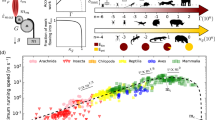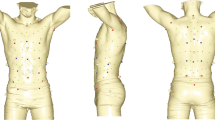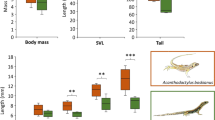Abstract
Striding bipedalism is a key derived behaviour of hominids that possibly originated soon after the divergence of the chimpanzee and human lineages. Although bipedal gaits include walking and running, running is generally considered to have played no major role in human evolution because humans, like apes, are poor sprinters compared to most quadrupeds. Here we assess how well humans perform at sustained long-distance running, and review the physiological and anatomical bases of endurance running capabilities in humans and other mammals. Judged by several criteria, humans perform remarkably well at endurance running, thanks to a diverse array of features, many of which leave traces in the skeleton. The fossil evidence of these features suggests that endurance running is a derived capability of the genus Homo, originating about 2 million years ago, and may have been instrumental in the evolution of the human body form.
This is a preview of subscription content, access via your institution
Access options
Subscribe to this journal
Receive 51 print issues and online access
$199.00 per year
only $3.90 per issue
Buy this article
- Purchase on Springer Link
- Instant access to full article PDF
Prices may be subject to local taxes which are calculated during checkout




Similar content being viewed by others
References
Haile-Selassie, Y. Late Miocene hominids from the Middle Awash, Ethiopia. Nature 412, 178–181 (2001)
Galik, Y. et al. External and internal morphology of the BAR 1002′00 Orrorin tugenensis femur. Science 305, 1450–1453 (2004)
Ward, C. V. Interpreting the posture and locomotion of Australopithecus afarensis: where do we stand? Yb. Physical Anthropol. 35, 185–215 (2002)
Aiello, L. & Dean, M. C. An Introduction to Human Evolutionary Anatomy (Academic, London, 1990)
Rose, M. D. in Origine(s) de la Bipédie chez les Hominides (eds Coppens, Y. & Senut, B.) 37–49 (CNRS, Paris, 1991)
Jungers, W. L. Relative joint size and hominid locomotor adaptations with implications for the evolution of hominid bipedalism. J. Hum. Evol. 17, 247–265 (1988)
Ruff, C. B. et al. in Primate Locomotion: Recent Advances (ed. Strasser, E.) 449–469 (Plenum, New York, 1998)
Wood, B. & Collard, M. The human genus. Science 284, 65–71 (1999)
Carrier, D. R. The energetic paradox of human running and hominid evolution. Curr. Anthropol. 25, 483–495 (1984)
Heinrich, B. Why We Run: A Natural History (Harper Collins, New York, 2002)
Garland, T. Jr. The relation between maximal running speed and body-mass in terrestrial mammals. J. Zool. 199, 157–170 (1983)
Taylor, C. R., Heglund, N. C. & Maloiy, G. M. Energetics and mechanics of terrestrial locomotion. I. Metabolic energy consumption as a function of speed and body size in birds and mammals. J. Exp. Biol. 97, 1–21 (1982)
Pennycuick, C. J. in Serengeti: Dynamics of an Ecosystem (eds Sinclair, A. R. E. & Norton-Griffiths, M.) 164–184 (Univ. Chicago Press, Chicago, 1979)
Holekamp, K. E., Boydston, E. E. & Smale, E. in How and Why Animals Travel in Groups (eds Boinski, S. & Garber, P.) 587–627 (Univ. Chicago Press, Chicago, 2000)
Alexander, R. M. Optimum walking techniques for quadrupeds and bipeds. J. Zool. Lond. 192, 97–117 (1980)
Margaria, R., Cerretelli, P., Aghemo, P. & Sassi, G. Energy cost of running. J. Appl. Physiol. 18, 367–370 (1963)
Alexander, R. M. Energy-saving mechanisms in walking and running. J. Exp. Biol. 160, 55–69 (1991)
Cavagna, G. A., Thys, H. & Zamboni, A. The sources of external work in level walking and running. J. Physiol. Lond. 262, 639–657 (1976)
Ker, R. F. et al. The spring in the arch of the human foot. Nature 325, 147–149 (1987)
Farley, C. T., Glasheen, J. & McMahon, T. A. Running and springs: speed and animal size. J. Exp. Biol. 185, 71–86 (1993)
Cavanagh, P. R. & Kram, R. Stride length in distance running: velocity, body dimensions, and added mass effects. Med. Sci. Sports Exerc. 21, 467–479 (1989)
Hunt, K. D. Mechanical implications of chimpanzee positional behavior. Am. J. Phys. Anthropol. 86, 521–536 (1991)
Isbell, L. A. et al. Locomotor activity differences between sympatric patas monkeys (Erythrocebus patas) and vervet monkeys (Cercopithecus aethiops): implications for the evolution of long hindlimb length in Homo. Am. J. Phys. Anthropol. 105, 199–207 (1998)
Alexander, R. M., Jayes, A. S. & Ker, R. F. Estimates of energy cost for quadrupedal running gaits. J. Zool. Lond. 190, 155–192 (1980)
Heglund, N. C. & Taylor, C. R. Speed, stride frequency and energy cost per stride. How do they change with body size and gait? J. Exp. Biol. 138, 301–318 (1988)
Hoyt, D. F. & Taylor, C. R. Gait and the energetics of locomotion in horses. Nature 292, 239–240 (1981)
Minetti, A. E. Physiology: efficiency of equine express postal systems. Nature 426, 785–786 (2003)
National Center for Chronic Disease Prevention and Health Promotion. Participation in Physical Activities: Adults Aged 18 and Over (National Health Information Survey, 1998, now age-adjusted to 2000 population); 〈http://www.cdc.gov/nccdphp/dnpa/physical/stats/pasports.htm〉.
Taylor, C. R. & Rowntree, V. J. Running on two or on four legs: which consumes more energy? Science 179, 186–187 (1973)
Thorpe, S. K. et al. Dimensions and moment arms of the hind- and forelimb muscles of common chimpanzees (Pan troglodytes). Am. J. Phys. Anthropol. 110, 179–199 (1999)
Swindler, D. R. & Wood, C. D. An Atlas of Primate Gross Anatomy: Baboon, Chimpanzee and Man (Univ. Washington Press, Seattle, 1973)
Susman, R. L., Stern, J. T. & Jungers, W. L. Arboreality and bipedality in the Hadar hominids. Folia Primatol. 43, 113–156 (1984)
Latimer, B. & Lovejoy, C. O. The calcaneus of Australopithecus afarensis and its implications for the evolution of bipedality. Am. J. Phys. Anthropol. 78, 369–386 (1989)
Stern, J. T. & Susman, R. L. The locomotor anatomy of Australopithecus afarensis. Am. J. Phys. Anthropol. 60, 279–317 (1983)
Clarke, R. J. & Tobias, P. V. Sterkfontein Member 2 foot bones of the oldest South African hominid. Science 269, 521–524 (1995)
Harcourt-Smith, W. E. H. Form and Function in the Hominoid Tarsal Skeleton Thesis, Univ. College London (2002)
Lewis, O. J. Functional Morphology of the Evolving Hand and Foot (Oxford Univ. Press, Oxford, 1989)
Reynolds, T. R. Stride length and its determinants in humans, early hominids, primates, and mammals. Am. J. Phys. Anthropol. 72, 101–115 (1987)
Kram, R. & Taylor, C. R. Energetics of running: a new perspective. Nature 346, 265–267 (1990)
Haeusler, M. & McHenry, H. M. Body proportions of Homo habilis reviewed. J. Hum. Evol. 46, 433–465 (2004)
Myers, M. J. & Steudel, K. Effect of limb mass and its distribution on the energetic cost of running. J. Exp. Biol. 116, 363–373 (1985)
Zihlman, A. L. & Brunker, L. Hominid bipedalism: then and now. Yb. Physical Anthropol. 22, 132–162 (1979)
Mero, A., Jaakkola, L. & Komi, P. V. Relationships between muscle fibre characteristics and physical performance capacity in trained athletic boys. J. Sports Sci. 9, 161–171 (1991)
Yang, N. et al. ACTN3 genotype is associated with human elite athletic performance. Am. J. Hum. Genet. 73, 627–631 (2003)
Keller, T. S. et al. Relationship between vertical ground reaction force and speed during walking, slow jogging, and running. Clin. Biomech. 11, 253–259 (1996)
Rose, M. D. A hominine hip bone, KNM-ER 3228, from East Lake Turkana, Kenya. Am. J. Phys. Anthropol. 63, 371–378 (1984)
Sanders, W. J. Comparative morphometric study of the australopithecine vertebral series Stw-H8/H41. J. Hum. Evol. 34, 249–302 (1998)
Biewener, A. A. & Taylor, C. R. Bone strain: a determinant of gait and speed? J. Exp. Biol. 123, 383–400 (1986)
Hinrichs, R. N. in Biomechanics of Distance Running (ed. Cavanagh, P. R.) 107–133 (Human Kinetics Books, Champaign, Illinois, 1990)
McLay, I. S., Lake, M. J. & Cavanagh, P. R. in Biomechanics of Distance Running (ed. Cavanagh, P. R.) 165–186 (Human Kinetics Books, Champaign, Illinois, 1990)
Jellema, L. M., Latimer, B. & Walker, A. in The Nariokotome Homo erectus Skeleton (eds Walker, A. & Leakey, R. E. F.) 294–325 (Harvard Univ. Press, Cambridge, 1993)
Aiello, L. & Wheeler, P. The expensive tissue hypothesis: the brain and digestive system in human and primate evolution. Curr. Anthropol. 36, 199–221 (1995)
Spoor, F., Wood, B. & Zonneveld, F. Implications of early hominid labyrinthine morphology for evolution of human bipedal locomotion. Nature 369, 645–648 (1994)
Bianchi, M. The thickness, shape and arrangement of the elastic fibres within the nuchal ligament from various animal species. Anat. Anz. Jena 169, 53–66 (1989)
Wheeler, P. E. The thermoregulatory advantages of hominid bipedalism in open equatorial environments: the contribution of increased convective heat loss and cutaneous evaporative cooling. J. Hum. Evol. 21, 107–115 (1991)
Ruff, C. B. Climate and body shape in hominid evolution. J. Hum. Evol. 21, 81–105 (1990)
Falk, D. Brain evolution of Homo: the radiator theory. Behav. Brain Sci. 13, 333–381 (1990)
Cabanac, M. & Caputa, M. Natural selective cooling of the human brain: evidence of its occurrence and magnitude. J. Physiol. Lond. 286, 255–264 (1979)
Niinimaa, V., Cole, P., Mintz, S. & Shephard, R. J. The switching point from nasal to oronasal breathing. Resp. Physiol. 42, 61–71 (1981)
Semaw, S. et al. 2.6-Million-year-old stone tools and associated bones from OGS-6 and OGS-7, Gona, Afar, Ethiopia. J. Hum. Evol. 45, 169–177 (2003)
Nabokov, P. Indian Running: Native American History and Tradition (Ancient City, Santa Fe, New Mexico, 1987)
O'Connell, J. F., Hawkes, K. & Blurton-Jones, N. G. Hadza scavenging: implications for Plio-Pleistocene hominid subsistence. Curr. Anthropol. 29, 356–363 (1988)
Wrangham, R. W. et al. The raw and the stolen: cooking and the ecology of human origins. Curr. Anthropol. 5, 567–594 (1999)
Muybridge, E. The Human Figure in Motion (Dover, New York, 1985)
Walker, A. & Leakey, R. E. F. The Nariokotome Homo erectus skeleton (Harvard Univ. Press, Cambridge, 1993)
Lovejoy, O. Evolution of human walking. Sci. Am. 259, 118–125 (1988)
Dillman, C. J. Kinematic analyses of running. Exercise Sports Sci. Rev. 3, 193–218 (1975)
Acknowledgements
We are grateful to A. Biewener, D. Carrier, W. Harcourt-Smith, F. Jenkins, Jr, J. McGrath, D. Pilbeam, J. Polk, H. Pontzer and R. Wrangham for discussion and comments on the manuscript. Funding was provided by the American School of Prehistoric Research; illustrations in Fig. 4 were rendered by L. Meszoly. D.M.B. and D.E.L. contributed equally to this work.
Author information
Authors and Affiliations
Corresponding authors
Ethics declarations
Competing interests
The authors declare that they have no competing financial interests.
Rights and permissions
About this article
Cite this article
Bramble, D., Lieberman, D. Endurance running and the evolution of Homo. Nature 432, 345–352 (2004). https://doi.org/10.1038/nature03052
Received:
Accepted:
Issue Date:
DOI: https://doi.org/10.1038/nature03052
This article is cited by
-
Muscle synergies inherent in simulated hypogravity running reveal flexible but not unconstrained locomotor control
Scientific Reports (2024)
-
Limits of Ultra: Towards an Interdisciplinary Understanding of Ultra-Endurance Running Performance
Sports Medicine (2024)
-
A century of exercise physiology: concepts that ignited the study of human thermoregulation. Part 4: evolution, thermal adaptation and unsupported theories of thermoregulation
European Journal of Applied Physiology (2024)
-
Arched footprints preserve the motions of fossil hominin feet
Nature Ecology & Evolution (2023)
-
The aorta in humans and African great apes, and cardiac output and metabolic levels in human evolution
Scientific Reports (2023)
Comments
By submitting a comment you agree to abide by our Terms and Community Guidelines. If you find something abusive or that does not comply with our terms or guidelines please flag it as inappropriate.



